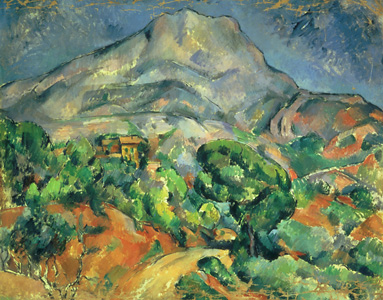Cézanne, << say ZAHN, >> Paul (1839-1906), a French painter, was one of the most important artists of the late 1800’s and the early 1900’s. He was a central figure in the European art movement known as Postimpressionism.
Early in his career, Cézanne painted in the Impressionist style, which tried to capture fleeting impressions and the effects of light. But Cézanne came to believe that color and form were inseparable, and he tried to emphasize strong structure in his work. His oil paintings expressed a new manner of portraying nature that departed from Impressionism. The paintings of his last years influenced many younger artists, especially those who painted in the Fauve and Cubist styles of the early 1900’s.
Cézanne was born on Jan. 19, 1839, in Aix-en-Provence, France. He attended several universities and studied law before becoming an artist in 1861. Cézanne was strongly influenced by the works of the French artist Eugène Delacroix, the Flemish artist Peter Paul Rubens, and the Italian artist Tintoretto. He copied the works of these painters at the Louvre museum in Paris. Cézanne especially admired the paintings of Gustave Courbet, a French artist of the 1800’s. The Courbet influence is reflected in the coarse application of paint and the emphasis on dark colors found in Cézanne’s earliest paintings. Many of these works deal with such subjects as murder and rape.
Cézanne’s style changed while working with the French Impressionist painter Camille Pissarro from 1872 to 1874. Like the Impressionists, Cézanne worked outdoors and made studies of his themes. However, he ultimately rejected the Impressionist style, declaring that he wanted to make of Impressionism something solid and enduring, like the art in museums.

Cézanne’s style became more architectural as he placed more emphasis on mass and structure in his compositions. His continuing separation from Impressionism was inspired by his belief that the painter must be an interpreter of nature, in addition to making a record of its beauty. His desire to interpret nature and the complexities of human thought and vision allied him with other Postimpressionists, such as Paul Gauguin of France and Vincent van Gogh of the Netherlands.
After his father died in 1886, Cézanne lived mainly in Aix-en-Provence in the south of France. The landscapes of Provence became a favorite subject in his art. He developed a style that combined many of the previous experiments in color and form that he had begun while working with Pissarro. Cézanne began to use areas of flat color, defined by large brushstrokes, to cover the surface of the canvas. His choice of colors during this period reflected nature, but the colors were more intensely pure than anything in his previous style.
Cézanne painted numerous scenes of Mont Sainte-Victoire, a mountain near Aix-en-Provence, from the mid-1880’s until his death. In the landscapes of this period, Cézanne abandoned traditional concepts of portraying space, such as painting successive planes that defined the depth of a scene. Instead, he emphasized the foreground by using asymmetrical views. In these works, his brushstrokes became broader and thicker. In his paintings of Mont Sainte-Victoire, Cézanne presented a clear geometric structure that achieved a balance of both color and form.
In addition to landscapes and seascapes, Cézanne painted interior scenes, portraits, and still lifes. He also completed many drawings and water colors. His late works demonstrate his continued fascination with nature and with finding a means to express himself through it. These late works show him to be at the turning point between the artistic worlds of the 1800’s and 1900’s. Cézanne’s series of paintings of bathers (1895-1906) pointed toward such Cubist works as the Spanish artist Pablo Picasso’s revolutionary painting Les Demoiselles d’Avignon (1907). Cézanne died on Oct. 23, 1906.
See also Painting (Postimpressionism) ; Postimpressionism .
